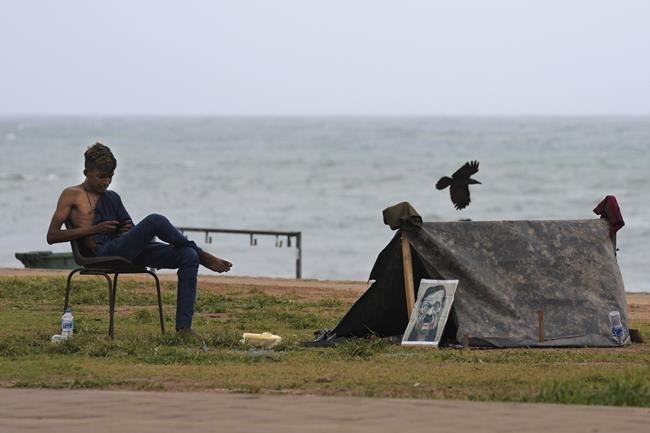COLOMBO, Sri Lanka (AP) — Sri Lankan authorities deployed armored vehicles and troops on the streets of the capital Wednesday, two days after pro-government mobs attacked peaceful protesters, triggering a wave of violence across the country.
Security forces have been ordered to shoot those deemed to be participating in the violence, as sporadic acts of arson and vandalism continued despite a strict nationwide curfew that began Monday evening.
Anti-government protests have been demanding the resignations of President Gotabaya Rajapaksa and his brother, who stepped down as prime minister this week, over a debt crisis that has nearly bankrupted Sri Lanka and left its people facing shortages of fuel, food and other essentials. In the past few days, eight people have died and more than 200 left injured amid violent attacks that have seen mobs set fire to buildings and vehicles.
Armored trucks with soldiers riding atop were seen rolling into some areas of Colombo. Defying the curfew, some protesters regrouped opposite the president’s office to continue demonstrations that began over three weeks ago.
Videos posted on social media showed lines of military trucks moving out of the capital, along with soldiers riding on motorbikes and setting up checkpoints across the country, amid fears that a political vacuum could pave the way for a military takeover.
The Defense Ministry's top official, Kamal Gunaratne, denied allegations of a military takeover, at a news conference jointly held with the country's army and navy chiefs.
“None of our officers have a desire to take over the government. It has never happened in our country and it is not easy to do it here,” said Gunaratne. President Gotabaya Rajapaksa is himself a former top army officer and remains the country's official defense minister.
Gunaratne said the army will return to its barracks once the security situation normalizes.
Navy commander Nishantha Ulugetenne said the former prime minister, Mahinda Rajapaksa, is being protected at the naval base in Trincomalee on the northeastern coast.
After Mahinda Rajapaksa resigned, he and his family were evacuated from his official residence through thousands of protesters trying to break into the heavily guarded, colonial-era building.
The Indian Embassy denied social media speculation that “certain political persons and their families have fled to India," and also rejected speculation that India was sending troops into Sri Lanka.
The country reaffirmed its support to Sri Lanka on Tuesday, saying India had extended support of $3.5 billion to help it overcome the crisis, as well sent essential items like food and medicine, the Ministry of External Affairs in New Delhi said.
On Monday, supporters gathered at the prime minister’s official residence to urge Mahinda Rajapaksa to stay in office. After the meeting, mobs supporting the government beat peaceful protesters who had camped out near the prime minister’s residence and president’s office demanding their resignations, as police watched and did little to stop them. Across the country, angry citizens responded by attacking government supporters and ruling party politicians.
Eight people including a ruling party lawmaker and two police officers were killed and 219 were injured in the violence, the defense ministry said. In addition, 104 buildings and 60 vehicles were burned.
Pro-government mobs were chased, beaten and stripped. Some who were pushed into a lake were not allowed to get back to ground for hours. As word spread of where buses were taking the supporters, people smashed them up and set them on fire.
Toppled buses were still smoking across the capital, Colombo, as protests continued. Homes of government supporters were attacked and some businesses were set on fire, though the personal violence subsided.
The European Union called on the authorities to initiate an investigation into the events and to hold accountable those instigating or perpetrating violence.
Sri Lanka is nearing bankruptcy having said that it is suspending payment of $7 billion of foreign loans it was due to pay this year out of a $25 billion due by 2026. Its total foreign debt is $51 billion.
The shortage of foreign currency has led to less imports and acute shortages of essentials from food to cooking gas, fuel and medicine. For the past months people have been forced to stay in long lines for hours to buy the limited stocks and many were returning with nothing.
Protesters blamed the Rajapaksa brothers' alleged corruption and style of administration for the economic crisis.
The prime minister's departure has created an administration vacuum with no Cabinet, which dissolved automatically with the resignation.
The void has also created fears of a military takeover especially if violence continues.
The U.S State Department expressed “concern” over the military deployment in Sri Lanka.
“We are, as I said before, also closely monitoring the deployment of troops, something that is of concern to us,” spokesman Ned Price told a weekly news conference.
Krishan Francis, The Associated Press



